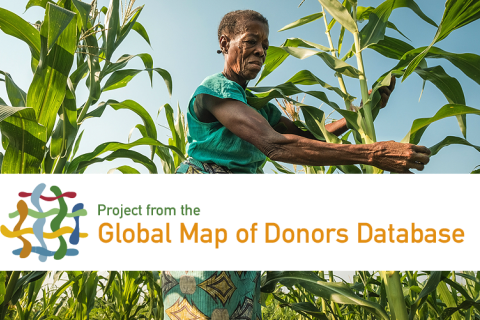The Global Donor Platform for Rural Development is a network of 38 bilateral and multilateral donors, international financing institutions, intergovernmental organisations and development agencies.
Members share a common vision that agriculture and rural development is central to poverty reduction, and a conviction that sustainable and efficient development requires a coordinated global approach.
Following years of relative decline in public investment in the sector, the Platform was created in 2003 to increase and improve the quality of development assistance in agriculture, rural development and food security.
// Agriculture is the key to poverty reduction
Agriculture, rural development, and food security provide the best opportunity for donors and partner country governments to leverage their efforts in the fight against poverty.
However, the potential of agriculture, rural development and food security to reduce poverty is poorly understood and underestimated.
Cutting-edge knowledge of these issues is often scattered among organisations, leading to competition, duplication of efforts, and delays in the uptake of best practices.
// Addressing aid effectiveness
Therefore the Platform promotes the principles of the Paris Declaration on Aid Effectiveness, the Accra Agenda for Action for sustainable outcomes on the ground, and the Busan Global Partnership for Effective Development Cooperation.
Increasing aid to agriculture and rural development is not enough. Donors must work together to maximise development impact.
// Adding value
The Platform adds value to its members’ efforts by facilitating the exchange of their development know-how, which consolidates into a robust knowledge base for joint advocacy work.
Working with the Platform, members are searching for new ways to improve the impact of aid in agriculture and rural development.
- An increased share of official development assistance going towards rural development
- Measurable progress in the implementation of aid effectiveness principles
- Greater use of programme-based and sector-wide approaches
- More sustainable support to ARD by member agencies
// Vision
The Platform endorses and works towards the common objectives of its member institutions to support the reduction of poverty in developing countries and enhance sustainable economic growth in rural areas.
Its vision is to be a collective, recognised and influential voice, adding value to and reinforcing the goals of aid effectiveness in the agricultural and rural development strategies and actions of member organisations in support of partner countries.
// Evaluation
Between August and October 2014, the Global Donor Platform for Rural Development underwent an Evaluation. The evaluators interviewed across board focal points (FPs) of member organisations, partner institutions, staff of the secretariat and key agricultural and rural development experts from different organisations involved in the Platform initiatives. KIT reviewed Platform documentation of the past 10 years, online resources and services to complete the assessment.
According to the report, the change in overall global development objectives of the Post-2015 agenda and its sustainable development goals (SDG) will only reiterate the relevance of the Platform’s work in coordinating donor activities. Agriculture and rural development are incorporated in many of the SDGs. The targeted development of appropriate policies and innovative strategies will depend on increased, cross-sectoral cooperation which the Platform stands for. The achievement of the Platform’s objectives of advocacy, knowledge sharing and network facilitation functions remains to be a crucial contribution to agriculture and rural development.
Members:
Resources
Displaying 371 - 375 of 809NUFFIC: Strengthening/capacity building of human resources in land administration in Guatemala (NICHE)
General
Capacity building and strengthening of human resources in land administration (follow-up of the 2004-2009 NUFFIC project in Guatemala).
Climate-Related Modernisation of National Forest Policy and Piloting REDD Measures in the Philippines
General
The project objective is to orientate Philippine forestry policy towards climate protection goals by preventing deforestation (REDD) and in particular by developing a REDD strategy that considers the causes of deforestation and encompasses incentive systems for preventing deforestation and rehabilitating degraded forest areas and mangroves. Priority is given to efforts that promote good governance, participation of local and indigenous communities in forestry policy-making processes and clarification of land-use rights as well as conservation of biodiversity and poverty reduction.
Forest and climate protection on Panay
General
The project is seeking to protect this continuous expanse of forest and its endangered species. A further aim is to improve land use planning and put in place appropriate forestry and agroforestry practices to ensure sustainable use of natural resources in the areas bordering the forest. It is setting up an alliance of provinces and local authorities affected, designating critical habitats wherever possible across the entire forest area under the decentralised land-use planning process and then further developing them. In conjunction with local authorities, the project plans measures and ensures they are incorporated into their annual budgets. It is also establishing an ecologically sound agroforestry system in the buffer zone, driving forward largescale reforestation and working towards supplying local households with renewable, sustainably produced raw materials to generate energy.
Integrated Land Administration System Implementation – ILAS
General
Supporting the State Geodetic Administration and the Ministry of Justice in accelerating the efficiency of businesses processes in Land Registry and Cadastre in the framework of the Integrated Land Administration System Implementation (ILAS).
Participatory Integrated-Watershed Management Project (PIWAMP)
General
The aim of the project was to increase agricultural productivity of 12,000 poor rural households nationwide by empowering them to undertake and maintain integrated watershed management activities that enhance their livelihoods and protect their natural resources. Activities gave priority to the inclusion of women in training for rice and livestock production and vegetable cultivation, and in the improvement of their access to financial services. As with all other project activities, interventions related to land and natural resource governance specifically targeted women and enhanced their access to land.


